The second Stalinist blow. Liberation of Right-Bank Ukraine
In 1944, the Red Army won a series of brilliant victories over the Wehrmacht. They entered history as "ten Stalin strikes." The first Stalinist strike led to the defeat of Army Group North, the complete de-blockade of Leningrad and the liberation of Novgorod (The first "Stalinist strike": the complete elimination of the blockade of Leningrad). The German command began to transfer reserves to the north. In late January - early February 1944, the Red Army delivered a “second Stalinist strike”, even more powerful, in Right-Bank Ukraine. Soviet troops began the liberation of Right-Bank Ukraine. Given that the fighting continued in the north, the German command could not transfer reinforcements from there.
prehistory
The military and political leadership of the Third Reich did not accept the fact that the Russians were winning the battle for Ukraine. Army Group South, under the command of Erich von Manstein, was ordered to hold food-rich areas of Right-Bank and Western Ukraine at any price. Of great importance was Nikopol with its enterprises for the extraction and processing of manganese, Krivoy Rog iron ore basin, the ports of southern Ukraine and the Crimean peninsula. Crimea was of great military-strategic importance, the peninsula firmly covered the southern wing of the Eastern Front, was for the Germans "unsinkable aircraft carrier" and the base for their naval forces.
In addition, to the south of Kiev, in the area of Kanev and Korsun-Shevchenkovsky, the Wehrmacht retained a bridgehead on the bank of the Dnieper. In the lower reaches of the Dnieper, the German troops had another large bridgehead on the banks of the Dnieper in the Nikopol area (they even retained part of the left bank) and Kherson. Hitler demanded to restore the front line on the Dnieper and clear the way to the Crimea. Korsun-Shevchenskovsky ledge was considered as a springboard for a strike on the Soviet troops.
Four soviet fronts operated in the south. The 1-th Ukrainian front, under the command of Nikolai Fyodorovich Vatutin, liberated Kiev and, continuing the offensive, freed Zhytomyr, Berdichev, went to Vinnitsa. To the south, the 2-th Ukrainian Front was under the command of Ivan Stepanovich Konev. Farther south, the enemy was oppressed by the 3-th Ukrainian Front under the leadership of Rodion Yakovlevich Malinovsky and the 4-th Ukrainian Front by Fyodor Ivanovich Tolbukhin. The coordination of their actions was carried out by Deputy Supreme Commander Georgy Konstantinovich Zhukov.
Even before the deployment of the main operations of the “second Stalinist strike”, the troops of the 1-th Ukrainian Front 24 of December 1943 of the year launched an offensive and three days later liberated Radomyshl. The Soviet troops during the Zhytomyr-Berdichev operation eliminated the consequences of the German counteroffensive, which the enemy conducted in November. 1 January 1944, the Soviet troops re-liberated Zhytomyr, left 20 November 1943. 3 January Red Army approached Novgorod-Volyn. During the operation, Berdichev and Belaya Tserkov were also released. The front troops advanced 80-120 km and swept the Korsun-Shevchenko group from the north-west.
5 January 1944 of the year launched the 2 th Ukrainian Front. After fierce fighting on January 8, Kirovograd was liberated. Front troops advanced 40-50 km. However, they could not reach the line of the Southern Bug River. As a result of the operations of the 1 and 2 of the Ukrainian fronts, a deep projection was formed, which was defended by a large group of the enemy. Korsun-Shevchenkovsky ledge prevented the Soviet troops from reaching the Southern Bug.
Operation plan
January 12 The Supreme Command Headquarters sent a directive to 1-th and 2-th Ukrainian Front, where the task was set to surround and destroy the enemy's Korsun-Shevchenko group.
They planned to cut the Korsun-Shevchenkovsky ledge under the base. Zhukov, Vatutin and Konev developed a plan of operation to encircle and destroy the enemy group. Each front formed an attack fist of mobile and rifle formations. Komfronta Vatutin decided to strike the main blow on the 27-kilometer stretch of Tynovka, Koshevatoe. In the first echelon, the 40th and 27th combined-arms armies advanced, the 6th tank army. The Soviet command believed that, given the incompleteness of the German defense in this sector (the front was recently established here), a powerful strike would allow troops to quickly enter the operational space. By the end of the first day, the troops were supposed to advance 12-15 km. On the second day, take Zvenigorodka, and on the third day in the Shpola area, connect with the troops of the 2nd Ukrainian Front. In the future, the forces of the front were divided: the 6th Panzer Army was to hold the outer front, and the rest of the troops destroyed the German troops that had fallen into the "boiler".
KNEV’s 2 Ukrainian Front advanced on an 19-kilometer stretch in the Verbovka and Krasnosilka area. In the first echelon, units of the 4-th Guards Army, the 53-th Army and the 5-th Guards Tank Army attacked. In the breakthrough planned to enter the Cossack corps. On the third or fourth day, the Soviet troops were to go to the area of Zvenigorodka. After the encirclement of the German troops, the 5-I Guards Tank and 53-I armies were to create the outer ring of the encirclement, and the troops of the 4-th Guards and 52-th armies - the inner ring. In addition, 5-i and 7-I guards armies had to conduct a diversion operation in the Kirovograd area.
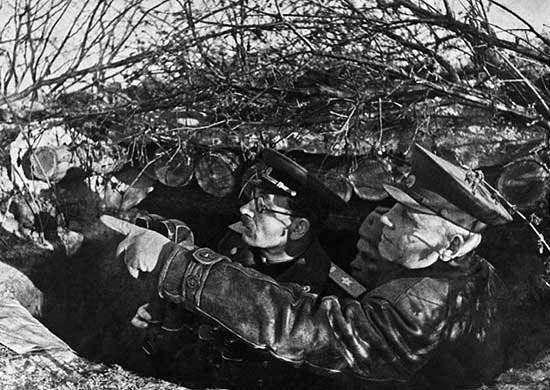
I.S. Konev and P.S. Captains at the observation post during the Korsun-Shevchenko offensive operation. 1944 Winter
German defense
The Korsun-Shevchenkovsky ledge was defended by units from the 7 and 42 army corps from the 1 tank army under the command of Hans Hubet, the 11 army corps and the 47 tank corps from the 8 army of Otto Wöhler. The ledge defended the 10 infantry and 2 tank divisions, the Walloon SS motorized brigade, as well as other formations. In addition, large tank reserves were located nearby: four tank divisions were located in the Kirovograd area, and three tank divisions of the 1 tank army in the Okhmatov area. Already during the battle, the German command also attracted additional infantry formations, some heavy tank battalions and other units. From the air, the German troops supported Otto Dessloh's 4 Air Fleet.
The German group consisted of more than 170 thousand people (a few tens of thousands of people entered the battle later), 1640 guns and mortars, 140 tanks and assault guns (according to other data more than 200), to 1000 aircraft. After encircling the Korsun-Shevchenko group for its de-blockade attracted about 500 tanks and assault guns.
German defense in the area of the ledge was different. On the Tynovka, Kagarlyk sector, where the Vatutin armies attacked, the front line was established only on January 10-12, so the Germans did not have time to equip a powerful line of defense here. Here the German defense relied on strong strongholds, covered with various obstacles and minefields. In the Kagarlyk, Moshny sector, the defensive line was established long ago. Here was a developed defensive system, with strong points, barrier lines. Therefore, in this direction, the Soviet troops did not plan to deliver the main attack.
In the offensive zone of the 2-th Ukrainian Front, the Germans were assisted by natural conditions. In the Moshny, Smila area, the terrain was covered with swamps, which hampered the movement of mechanized compounds. The German troops in this area mainly concentrated their efforts on the defense of the main lines of communication, which covered the centers of resistance. From Smela and further south, the front was well prepared for defense. The defense of the enemy consisted of two lanes. The main strip was well equipped, had strong points, resistance nodes, wire barriers, ditches, anti-personnel and anti-tank fields. The second line of defense was under construction. In general, the German troops, despite the heavy defeats of 1943 of the year, maintained high combat capability, defended themselves skillfully and carried out strong counterattacks.
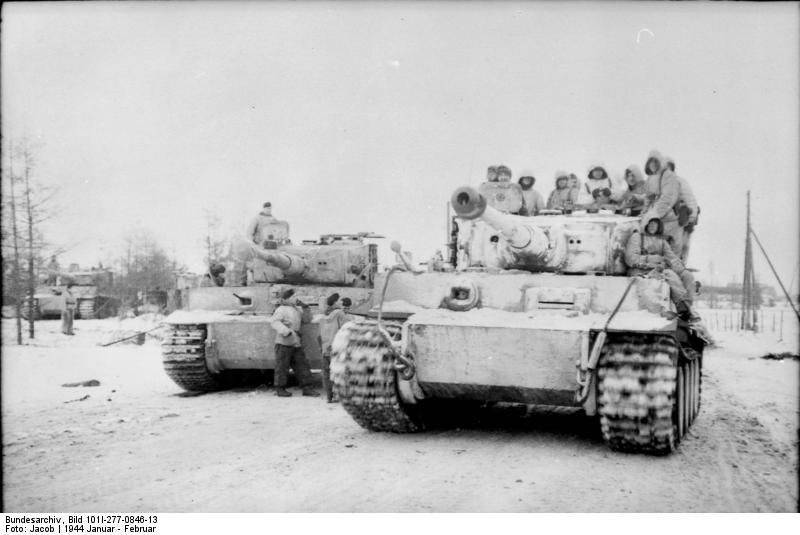
Soviet forces and operation preparation
The 40th Army of Philip Zhmachenko, the 27th Army of Sergey Trofimenko, the 6th Tank Army of Andrey Kravchenko of the 1st Ukrainian Front were involved in the operation. Part of the 2nd Air Army of Stepan Krasovsky covered them from the air. From the side of the 2nd Ukrainian Front, the 52nd Army of Konstantin Koroteyev, the 4th Guards Army of Alexander Ryzhov, the 53rd Army of Ivan Galanin, the 5th Guards Tank Army of Pavel Rotmistrov participated in the operation. From the air, the 2nd UV was covered by the 5th air army of Sergey Goryunov and the 10th fighter aviation Air Defense Corps.
For the operation was created a serious advantage over the enemy. The rate in January transferred Vatutin's 47 Army Vitaly Polenov, 2 Tank Army Semyon Bogdanov, 6 Guards Cavalry Corps Sergei Sokolov and Mikhail Volkov's 5 Mechanized Corps to Vatutin in January. The front of Konev was reinforced with the 5 Guards Don Cossack Corps under the command of Aleksey Selivanov, who was transferred from the offensive line of the 4 of the Ukrainian Front. From 22 January to 3 February, tank forces received 400 new T-34 tanks.
In total, the grouping of Soviet troops was more than 330 thousand people, 5300 guns and mortars (according to other data about 4 thousand), 376 tanks and SAU (according to other data about 600), more than 1 thousand aircraft.
Before the operation, shock groups were created. Konev, in the direction of the main attack from the Kirovograd area, transferred the 5 th Guards Tank Army of Rotmistrov, the breakthrough artillery division, and other reinforcement units. Vatutin strengthened the 27 and 40 army. As a result, by the beginning of the operation on the directions of the main strikes of the fronts, a great advantage was achieved over the enemy: in the 1-m Ukrainian front - double for infantry and three-fold for tanks and artillery; in the 2-th Ukrainian front, more than three times for infantry, six times for artillery and tenfold for tanks.
The complexity of the operation was that its preparation was carried out in a very short time (5-7 days). At the same time, the troops of the front conducted active operations in separate directions. Spring came early and the thaw began. Broken and muddy roads hindered the movement of troops, their movement, the supply of fuel and ammunition. Most airfields were unpaved and became unsuitable for takeoff and landing of aircraft. In the army there was a shortage of ammunition and fuel.
In general, the German command missed the preparation of the Soviet fronts. When Manstein began to target tank divisions at the breakthrough areas of the Soviet troops, it was already too late.
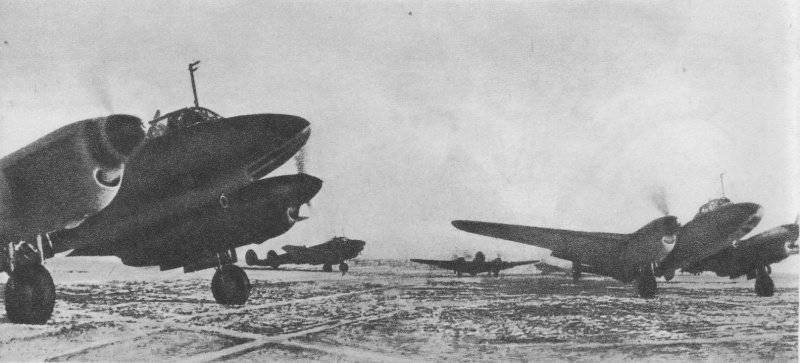
Pe-2 2-th Ukrainian Front dive bombers before taking off for a combat mission during the Korsun-Shevchenko offensive operation
The environment of the German group
Actions 2 of the Ukrainian Front. Early in the morning of January 24, the Korsun-Shevchenko operation began. After a powerful artillery training, reinforced advanced battalions of the 4-th Guards and 53-th armies went to storm the German positions. By the end of the day, they pushed the enemy to 2-6 km and captured the strongholds of the first line of defense, partially caught on the second lane.
On the morning of January 25, after a short artillery strike, the main forces of the Ryzhov and Galanin armies went on the offensive. Supported the offensive 5-I Guards Tank Army Rotmistrova. The defense of the 389 German Infantry Division began to fall apart under the onslaught of six Soviet divisions. By the end of the day, the 20 tank corps of Ivan Lazarev and the 29 tank corps of Ivan Kirichenko passed 18-20 km and reached Kapitanovka and Tishkovka. The German command began to transfer part of the 389-th infantry division to the aid of the 57 division. The German 3 Panzer Division and the 106 Infantry Division acted more successfully and held back the onslaught of the 53 Army. Here the Soviet arrows, almost without tank support, were able to advance only a few kilometers.
On January 26, Lazarev’s tank crews took Kapitanovka and reached Lebedin in the evening. On the night of Lebedin, where only the rear units of the 389 Infantry Division were, was released. Kirichenko Corps took Rossohovatku, repulsed the strike of the fighting group Langkeita from the 14-th Panzer Division. In addition, the von Breze battle group from the 14 Panzer Division was surrounded. On the same day, the counterattacks of the German reserves began - the 11 Panzer Division launched an offensive. By evening, she took part of Tishkovka.
January 27 The advanced units of the 20 tank corps took Shpolu. The 29 Corps freed Water, Lipianka and Mezhyhorka. The German command, realizing the danger of the situation, continued to hastily strengthen the counter-attack forces of the troops. In the Novo-Mirgorod area, three tank divisions were concentrated (3, 11, and part of 14), to the north of Pastora they assembled parts of three infantry and one tank division. The 11 Panzer Division established contact with the surrounded von Breze group northeast of Kapitanovka. As a result, the communications of the two Soviet tank corps were cut.
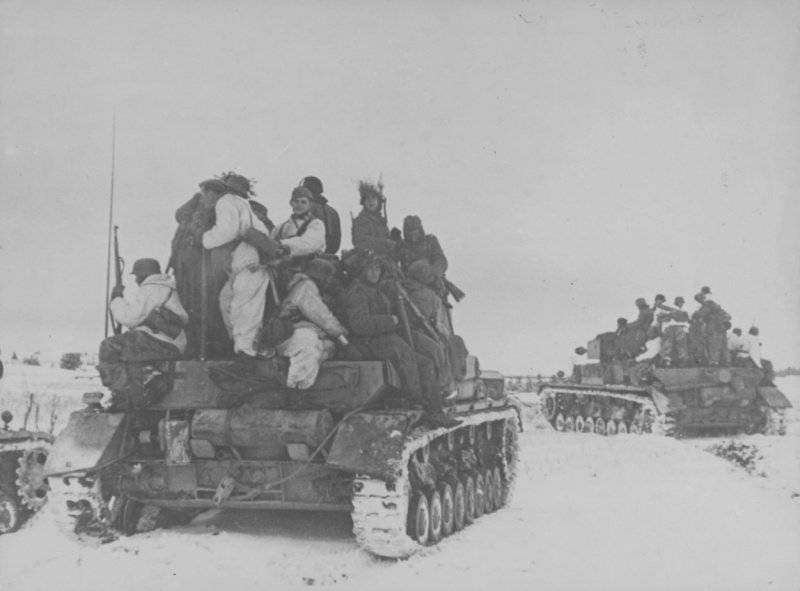
German tanks Pz.Kpfw. IV with soldiers on armor during the Korsun-Shevchenko Operation
However, it was not the 1941 year, our tankers did not panic, look at the rear and continued the offensive. The command of the 2 of the Ukrainian Front threw into battle the 25 tank tank brigade from the 29 tank corps, the 18 tank corps of Kuzma Trufanov from Rotmistrov’s army, the 5 Guards Don Cossack Corps corps. Ryzhova’s 4 Guards Army continued to push the German 389 and 72 Infantry Divisions, which were supported by part of the 57 Infantry Division and the SS Viking SS Panzer Division. The 5 Army continued its attack on the positions of the 53 Panzer Division and the 3 Infantry Division. After three days of stubborn fighting in the area of Kapitovka and Tishkovka, the Soviet troops rejected the enemy’s strike groups and reestablished communication with parts of the 106 and 20 units of the tank corps. On January 29, advanced units of the 28 tank corps entered Zvenigorodka and joined there with a mobile group of the 20 tank army of the 6 Ukrainian Front.
Actions 1 of the Ukrainian Front. On the morning of January 26, after a strong 40-minute artillery preparation, the offensive units of the 40, 27 and 6 tank armies of the 1 of the Ukrainian Front launched an attack. In the area of Tynovka, where units of the 40 Army were attacking with the support of the 5 Mechanized and 5 Guards Tank Corps, the Germans put up stubborn resistance, the advance of the troops was insignificant. Soviet mobile units suffered heavy losses. The best result was achieved in the defense zone of the 198 of the German Infantry Division, here the Soviet soldiers advanced 8-10 km. Moreover, the German command in the area of Okhmatov, by forces of two tank divisions, organized a counterattack on the right wing of the 40 Army. The 27 Army was advancing more successfully. The Soviet arrows, with minimal support from armored vehicles, broke through the defenses of the German 88 Infantry Division and advanced by 18 km.
The January 27 offensive in the main grouping area continued to develop slowly. 6-I tank army suffered significant losses in manpower and equipment. The front command decides to shift the main forces to the north. The 47 th rifle corps from the 40 th army are transferred to the 6 th Panzer Army. Volkov’s 5 th mechanized corps was transferred to the right flank of the 40 th army to repel a possible German strike from the Vinnitsa region. In addition, they formed a mobile group (233-I tank brigade, regiment SAU, motorized rifle battalion and anti-tank battery) with the task of making their way into Zvenyhorodka through Lisyanka. At night, the group took Lisyanka and on January 28, 13 made its way to Zvenigorodka in the afternoon. The mobile group of 1-UV was connected with the tank crews of the 155-th tank brigade of the 20-th tank corps. Tankers occupied all-round defense in anticipation of the main forces.
On January 31, units of the 27 Army Trofimenko (180 Infantry Division) and the Cossacks of the 5 Guards Corps met in the area of Olshany. The main forces of the 3 Guards Army, as well as units of the 4 Army, approached the 52 in February. The inner ring of the environment was closed. The 6-I tank army and 5-I Guards tank army formed the outer ring of the environment. The army of Rotmistrov was reinforced with the 49 rifle corps, two anti-tank fighter brigades, a separate heavy artillery brigade, a light artillery brigade and an engineering support brigade of the RGK. In addition, the outer flanks of the encirclement were defended by units of the 40 Army 1 UV and 53 Army 2 UV.
Thus, the Germans received the "Little Stalingrad". In the "boiler" was part of more than 10 German divisions (about 60 thousand. People). The entourage included: 1) 42 Army Corps - Corps Group B (112-I, 255-I and 332-I Infantry Divisions), 88-I Infantry Division; 2) 11 Army Corps: 57-I, 75-I, 389-I infantry divisions, 5-I tank SS division "Viking", 5-I motorized brigade of SS "Wallonia"; 3) part of the 47 tank corps - part of the 14 tank division; 4) part of the 7 Army Corps — connections of the 198 Infantry Division, etc. The German grouping was headed by the commander of the 11 Army Corps, Wilhelm Stemmermann.
To be continued ...
- Alexander Samsonov
- The first "Stalinist strike": the complete elimination of the blockade of Leningrad
The first "Stalinist strike." Part of 2. The liberation of Veliky Novgorod from the German invaders
The second Stalinist blow. Liberation of Right-Bank Ukraine
The second Stalinist blow. Part of 2. Destruction of the enemy's Korsun-Shevchenko grouping
The second Stalinist blow. Part of 3. The defeat of the Nikopol-Krivoy Rog adversary group
The second Stalinist blow. Part of 4. Proskurov-Chernivtsi offensive
The second Stalinist blow. Part of 5. Uman-Botosha operation
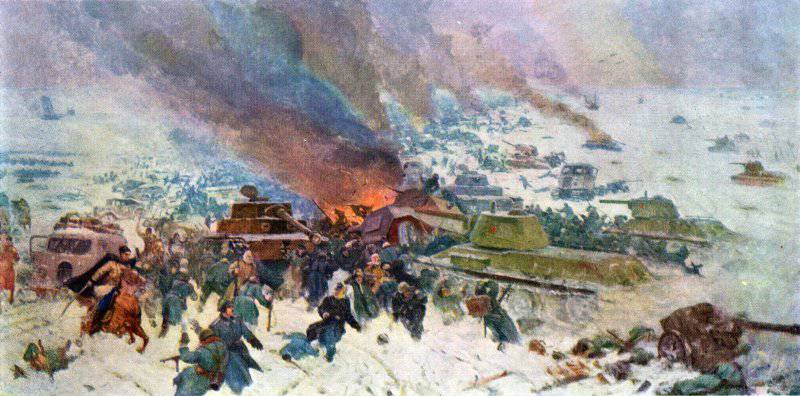
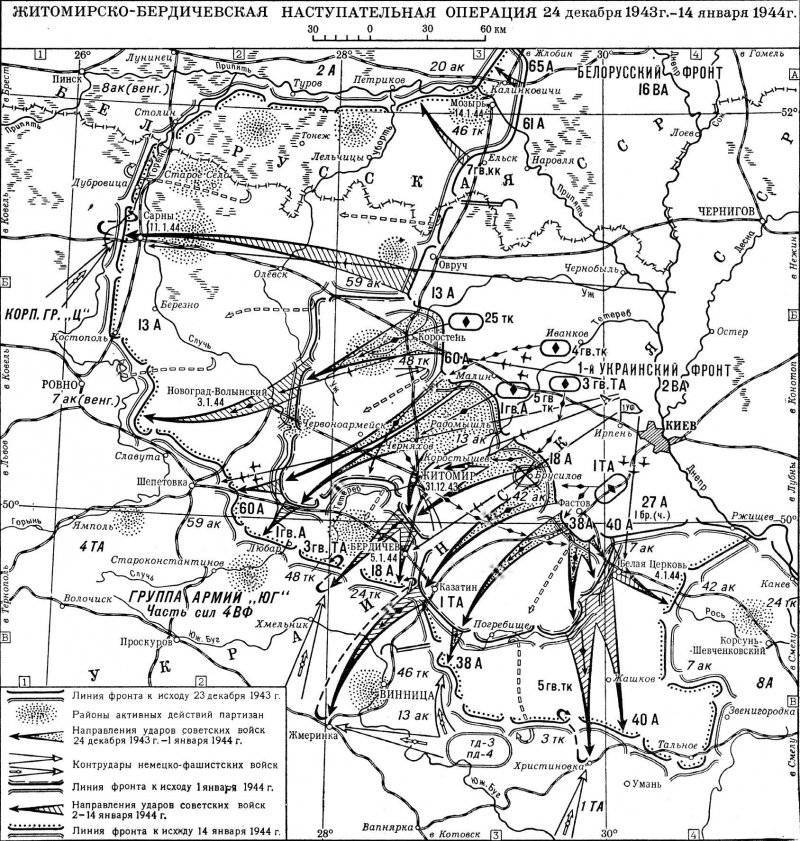
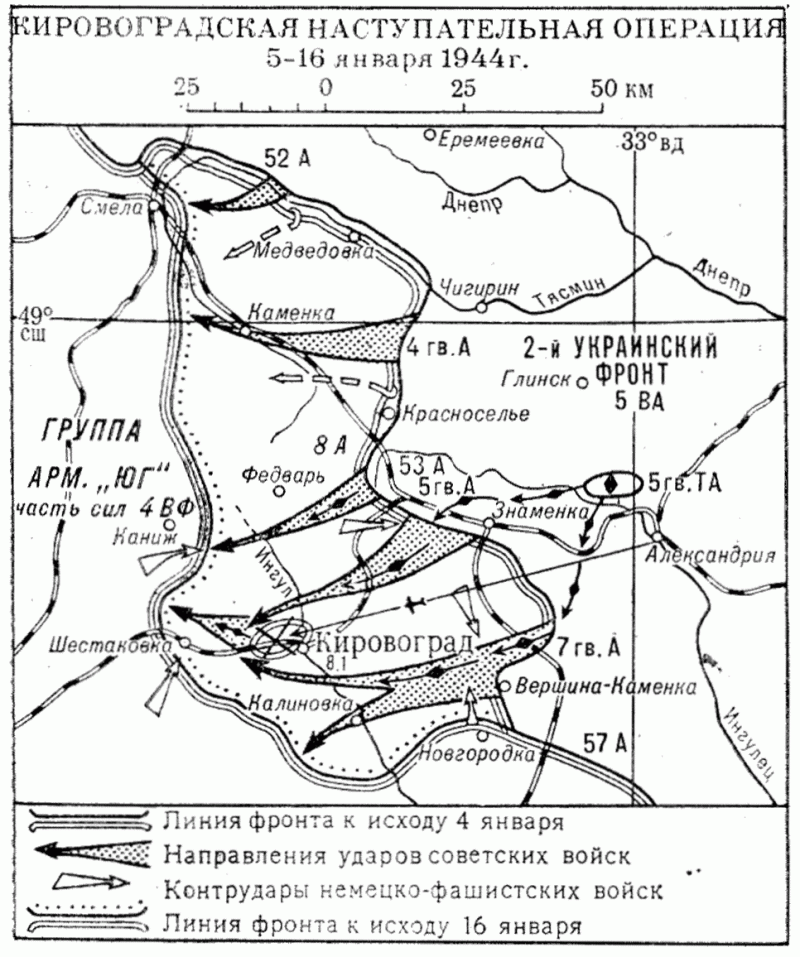
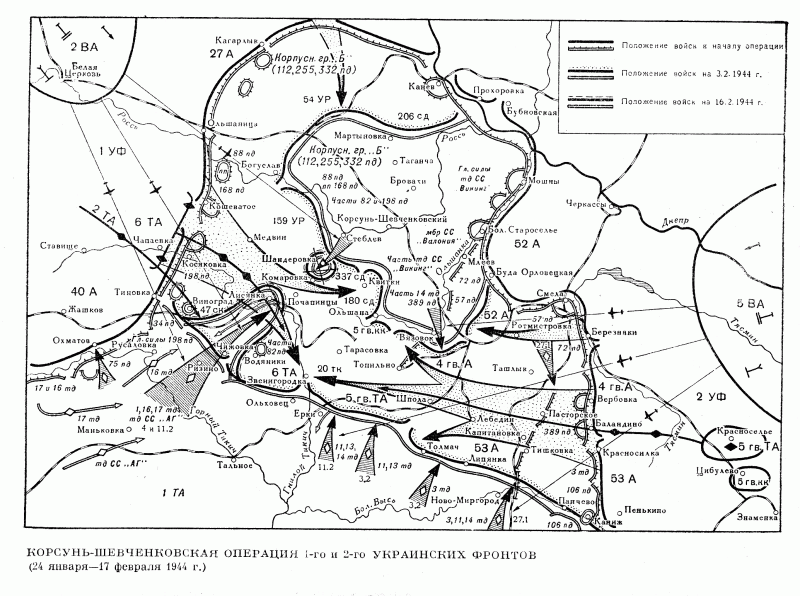
Information